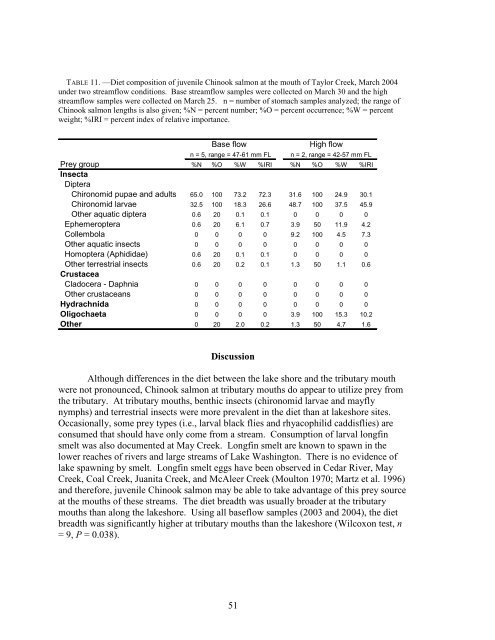Nearshore Habitat Use by Juvenile Chinook Salmon in Lentic ...
Nearshore Habitat Use by Juvenile Chinook Salmon in Lentic ...
Nearshore Habitat Use by Juvenile Chinook Salmon in Lentic ...
Create successful ePaper yourself
Turn your PDF publications into a flip-book with our unique Google optimized e-Paper software.
TABLE 11.—Diet composition of juvenile <strong>Ch<strong>in</strong>ook</strong> salmon at the mouth of Taylor Creek, March 2004<br />
under two streamflow conditions. Base streamflow samples were collected on March 30 and the high<br />
streamflow samples were collected on March 25. n = number of stomach samples analyzed; the range of<br />
<strong>Ch<strong>in</strong>ook</strong> salmon lengths is also given; %N = percent number; %O = percent occurrence; %W = percent<br />
weight; %IRI = percent <strong>in</strong>dex of relative importance.<br />
Base flow<br />
High flow<br />
n = 5, range = 47-61 mm FL n = 2, range = 42-57 mm FL<br />
Prey group %N %O %W %IRI %N %O %W %IRI<br />
Insecta<br />
Diptera<br />
Chironomid pupae and adults 65.0 100 73.2 72.3 31.6 100 24.9 30.1<br />
Chironomid larvae 32.5 100 18.3 26.6 48.7 100 37.5 45.9<br />
Other aquatic diptera 0.6 20 0.1 0.1 0 0 0 0<br />
Ephemeroptera 0.6 20 6.1 0.7 3.9 50 11.9 4.2<br />
Collembola 0 0 0 0 9.2 100 4.5 7.3<br />
Other aquatic <strong>in</strong>sects 0 0 0 0 0 0 0 0<br />
Homoptera (Aphididae) 0.6 20 0.1 0.1 0 0 0 0<br />
Other terrestrial <strong>in</strong>sects 0.6 20 0.2 0.1 1.3 50 1.1 0.6<br />
Crustacea<br />
Cladocera - Daphnia 0 0 0 0 0 0 0 0<br />
Other crustaceans 0 0 0 0 0 0 0 0<br />
Hydrachnida 0 0 0 0 0 0 0 0<br />
Oligochaeta 0 0 0 0 3.9 100 15.3 10.2<br />
Other 0 20 2.0 0.2 1.3 50 4.7 1.6<br />
Discussion<br />
Although differences <strong>in</strong> the diet between the lake shore and the tributary mouth<br />
were not pronounced, <strong>Ch<strong>in</strong>ook</strong> salmon at tributary mouths do appear to utilize prey from<br />
the tributary. At tributary mouths, benthic <strong>in</strong>sects (chironomid larvae and mayfly<br />
nymphs) and terrestrial <strong>in</strong>sects were more prevalent <strong>in</strong> the diet than at lakeshore sites.<br />
Occasionally, some prey types (i.e., larval black flies and rhyacophilid caddisflies) are<br />
consumed that should have only come from a stream. Consumption of larval longf<strong>in</strong><br />
smelt was also documented at May Creek. Longf<strong>in</strong> smelt are known to spawn <strong>in</strong> the<br />
lower reaches of rivers and large streams of Lake Wash<strong>in</strong>gton. There is no evidence of<br />
lake spawn<strong>in</strong>g <strong>by</strong> smelt. Longf<strong>in</strong> smelt eggs have been observed <strong>in</strong> Cedar River, May<br />
Creek, Coal Creek, Juanita Creek, and McAleer Creek (Moulton 1970; Martz et al. 1996)<br />
and therefore, juvenile <strong>Ch<strong>in</strong>ook</strong> salmon may be able to take advantage of this prey source<br />
at the mouths of these streams. The diet breadth was usually broader at the tributary<br />
mouths than along the lakeshore. Us<strong>in</strong>g all baseflow samples (2003 and 2004), the diet<br />
breadth was significantly higher at tributary mouths than the lakeshore (Wilcoxon test, n<br />
= 9, P = 0.038).<br />
51
















